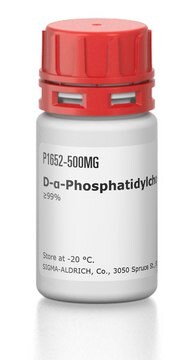850475C
Avanti
18:1-16:0 PC
1-oleoyl-2-palmitoyl-sn-glycero-3-phosphocholine, chloroform
Sinónimos:
1--(9Z-octadecenoyl)-2-hexadecanoyl-sn-glycero-3-phosphocholine; OPPC; PC(18:1(9Z)/16:0)
About This Item
Productos recomendados
Ensayo
>99% (TLC)
Formulario
liquid
envase
pkg of 1 × 2.5 mL (850475C-25mg)
pkg of 2 × 4 mL (850475C-200mg)
fabricante / nombre comercial
Avanti Research™ - A Croda Brand 850475C
concentración
10 mg/mL (850475C-25mg)
25 mg/mL (850475C-200mg)
tipo de lípido
cardiolipins
phospholipids
Condiciones de envío
dry ice
temp. de almacenamiento
−20°C
cadena SMILES
[P](=O)([O-])(OC[C@H](OC(=O)CCCCCCCCCCCCCCC)COC(=O)CCCCCCC\C=C/CCCCCCCC)OCC[N+](C)(C)C
InChI
1S/C42H82NO8P/c1-6-8-10-12-14-16-18-20-21-23-24-26-28-30-32-34-41(44)48-38-40(39-50-52(46,47)49-37-36-43(3,4)5)51-42(45)35-33-31-29-27-25-22-19-17-15-13-11-9-7-2/h20-21,40H,6-19,22-39H2,1-5H3/b21-20-/t40-/m1/s1
Clave InChI
RRVPPYNAZJRZFR-VYOBOKEXSA-N
Descripción general
Aplicación
- as a lipid standard in ultra-performance liquid chromatography (UPLC) analyses
- as a component in liposomes to study the cell proliferation of several cell lines
- in liposomes for cross-linking experiment
Acciones bioquímicas o fisiológicas
Envase
Información legal
Palabra de señalización
Danger
Frases de peligro
Clasificaciones de peligro
Acute Tox. 3 Inhalation - Acute Tox. 4 Oral - Carc. 2 - Eye Irrit. 2 - Repr. 2 - Skin Irrit. 2 - STOT RE 1 Oral - STOT SE 3
Órganos de actuación
Liver,Kidney, Respiratory system
Código de clase de almacenamiento
6.1D - Non-combustible acute toxic Cat.3 / toxic hazardous materials or hazardous materials causing chronic effects
Clase de riesgo para el agua (WGK)
WGK 3
Punto de inflamabilidad (°F)
does not flash
Punto de inflamabilidad (°C)
does not flash
Listados normativos
Los listados normativos se proporcionan para los productos químicos principalmente. Para los productos no químicos sólo se puede proporcionar información limitada. Si no hay ninguna entrada, significa que ninguno de los componentes está en la lista. Es obligación del usuario garantizar el uso seguro y legal del producto.
EU REACH Annex XVII (Restriction List)
Elija entre una de las versiones más recientes:
Certificados de análisis (COA)
It looks like we've run into a problem, but you can still download Certificates of Analysis from our Documentos section.
Si necesita más asistencia, póngase en contacto con Atención al cliente
¿Ya tiene este producto?
Encuentre la documentación para los productos que ha comprado recientemente en la Biblioteca de documentos.
Global Trade Item Number
| Número de referencia del producto (SKU) | GTIN |
|---|---|
| 850475C-25MG | 4061837792588 |
| 850475C-200MG |
Nuestro equipo de científicos tiene experiencia en todas las áreas de investigación: Ciencias de la vida, Ciencia de los materiales, Síntesis química, Cromatografía, Analítica y muchas otras.
Póngase en contacto con el Servicio técnico










